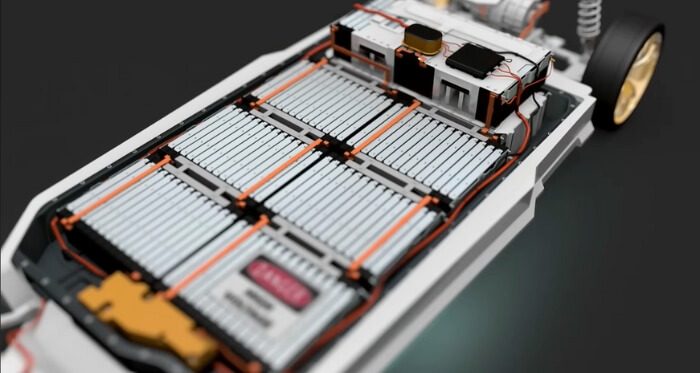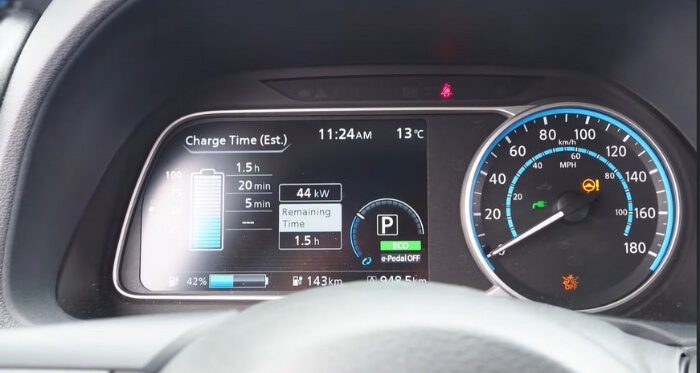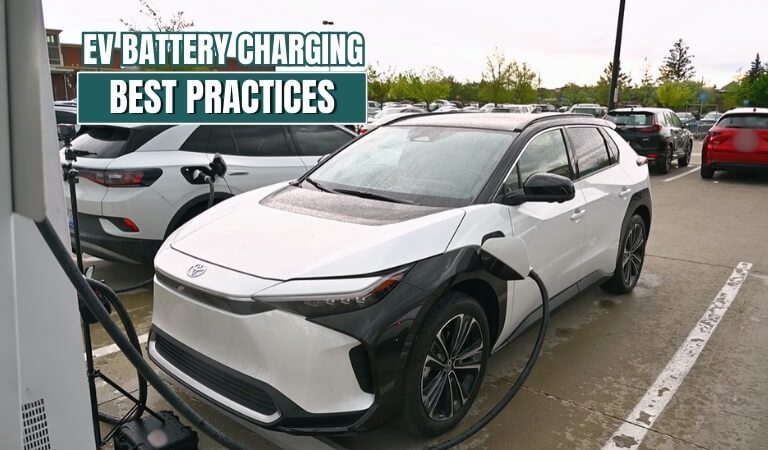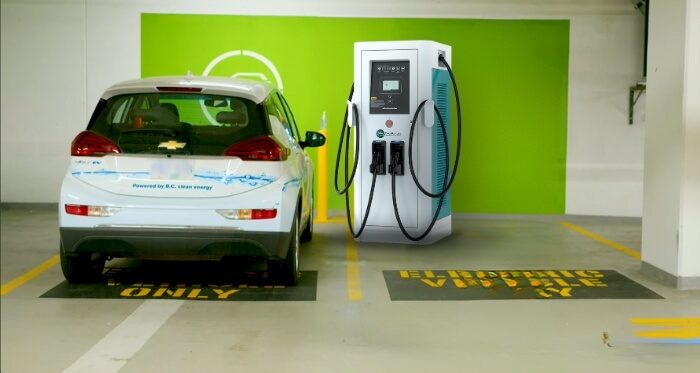The battery is considered the heart of EV cars because they don’t run on engine fuel but on electrical energy. Charging an EV at an appropriate charging station within the recommended time not only keeps the battery fine but also expands its lifetime.
If you don’t have the necessary EV charging and maintenance knowledge, several battery-related problems will occur. This is why a proper guidance is needed on EV battery charging best practices.
After you understand the right processes and adopting the best practices for EV charging, you can simply increase its lifespan over time.
However, here, we have picked the top 6 best and most effective practices that you can follow in your daily EV charging routine. Check out our top picks to prevent battery degradation and enhance the overall performance.
What is an EV Battery?
An EV runs on a rechargeable battery, which eliminates the need for traditional car fuel. Electric vehicle batteries primarily employ lithium-ion technology. It is made from positive and negative electrodes, an electrolyte, and a separator. These batteries come with a lightweight design and impressive energy storage capabilities.
The magic lies in their ability to efficiently store and release energy, making them the powerhouse behind the green revolution in transportation. Higher energy density is another exceptional characteristic of an EV battery.
How They Work?
The mechanism of an EV is more interesting. Charging an electric vehicle involves a fascinating interplay within the battery.
When connected to a charging station, an electric current flows, driving lithium ions from the negative electrode (anode) to the positive electrode (cathode) through the electrolyte.
The discharge process during driving sees these stored lithium ions making a return journey. This cyclic dance of electrons creates an electric current, fueling the motor and setting your EV in motion.
To be more specific and clear, check the steps of how the EV battery works when charging the car:

Charging
When you plug your EV into a charging station, an electric current flows into the battery. The electric current then initiates a fascinating journey for lithium ions within the battery.
Lithium-Ion Movement
The lithium ions, housed in the battery’s negative electrode (anode), start their migration towards the positive electrode (cathode). A flow of electric current is generated by this movement, which occurs through an electrolyte.
Storing Energy
As the lithium ions reach the positive electrode, they are stored there, ready for action. This charging process essentially fills the battery with stored energy, like filling a gas tank, but with electrons.
Discharging
When you drive your EV, the stored energy is released as the lithium ions move back to the negative electrode. An electric current is generated by this movement of the negative ion that powers the vehicle’s motor and start running.
Battery Management Systems (BMS)
To maintain a good balance in the motion of the ions, EV batteries are equipped with Battery Management Systems. These systems monitor and balance the charge and discharge processes, ensuring safety and optimizing the battery’s lifespan.
More specifically, charging fills the battery with energy, and driving releases that stored energy to power your car. It’s this elegant interplay of electrons and lithium ions that makes electric vehicles not just eco-friendly, but also a marvel of efficient and sustainable transportation.
The Factors that Affects EV Battery Health
Many factors are responsible for the degradation of an EV battery. Continuously repeating those can affect the vehicle’s battery significantly. Take a look at those factors below for a better understanding:

Charging at an Extreme Temperature
Temperature has a significant impact on EV batteries. Whatever the temperature, whether it is cold or hot, if it is in extreme mode, it will damage the battery. High temperatures usually cause battery degradation, while lower temperatures can hinder charging efficiency.
Impact of Charging Frequency on Battery Lifespan
The frequency of EV charging cycles needs to be in delicate balance. Regular charging is part of routine use. On the contrary, excessive charging and discharging can contribute to wear and tear over time.
Slight discharges, where only a small portion of the battery’s capacity is utilized, are generally less stressful on the battery than deep discharges. Adhering to the recommended depth of discharge can considerably contribute to extending the overall lifespan of your EV battery.
Charging Speed
Speed of the charging is another critical factor influencing battery health. Fast charging may be a convenient option, but frequent use may generate more heat, potentially impacting the long-term health of the battery.
State of Charge (SOC) Management
Not managing the state (SOC) is another impactful factor that can drain the EV battery over time. Consistently charging your EV to its full capacity or letting it reach extremely low levels can stress the battery.
Electrical cars have a preferred charging state of 20% to 80%, which means charging within this level is okay. But charging consistently to 100% can increase stress on the battery and contribute to a prolonged lifespan.
Top 6 EV Battery Charging Best Practices
All electrical devices need extra care to run for a long time. Similarly, an EV requires charging appropriately and following a schedule to optimize the battery performance over time. Here is our top 6 EV Battery Charging Best Practices that you can follow:

1. Optimal charging levels for daily use
Efficient management of EV battery charging is crucial for maximizing the battery lifespan. For daily use, it is recommended to maintain the percentage of charge between 20% and 80%.
Avoiding extremes like fully depleting or fully charging the battery can significantly enhance its longevity. Charging within this optimal range helps mitigate stress on the battery cells, minimizing wear and tear over time.
2. Charging Time Recommendations
The charging time for EV batteries depends on various factors, such as battery capacity, charger capacity, and charging infrastructure. In general, it is advisable to use Level 2 chargers for daily charging needs, as they strike a balance between charging speed and battery health.
DC fast charging can be utilized when required, but frequent reliance on it may impact the battery’s overall lifespan. Additionally, it’s essential to follow manufacturer recommendations for charging times to prevent overheating and ensure safety.
3. Charging Infrastructure
A reliable and well-maintained charging infrastructure is another effective EV charging practice. The use of reputable charging stations, like CrackPlatoon is highly essential because they always adhere to safety standards to prevent potential issues during charging.
Moreover, regularly updated maps or apps displaying charging station locations and availability can assist EV owners in planning routes, ensuring they have access to charging points when needed. A robust and widespread charging infrastructure is essential for promoting widespread EV adoption.
4. Neglecting Battery Management Systems
Modern EVs are equipped with sophisticated Battery Management Systems (BMS) that monitor and control various aspects of the battery’s performance. Neglecting regular maintenance and updates to the BMS can undermine the capability and safety of the battery.
So, you must follow manufacturer guidelines for BMS maintenance, ensuring that the system is functioning optimally to manage factors like temperature, voltage, and cell balancing.
5. Software and Firmware Updates
Regularly updating the software and firmware of an EV is crucial for enhancing performance, improving energy efficiency, and addressing potential security vulnerabilities.
Manufacturers often release updates to optimize battery management algorithms, charging protocols, and overall vehicle functionality. Staying informed about these updates and promptly installing them ensures that your EV benefits from the latest advancements, contributing to a safer and more efficient driving experience.
6. Plug and Cable Maintenance
Proper maintenance of charging plugs and cables is essential for ensuring a secure and efficient charging process. Regularly inspecting cables for wear and tear, cleaning connectors, and storing cables properly can prevent potential charging issues.
It’s also important to follow the manufacturer’s recommendations for plug and cable care, as neglecting these components can lead to safety hazards and affect the overall reliability of the charging system. Regular maintenance contributes to a smooth charging experience and extends the life of the charging equipment.
Best DC EV Charging Station In Bangladesh
DC or fast EV chargers are the most crucial for an EV among the other two chargers. If you regularly charge your EV with a fast charger, it will affect the battery over time. That’s why a high-quality EV charging service provider is essential.

A reliable and cost-effective fast EV charging station will not only quickly recharge but also cause no damage to the battery. CrackPlatoon is your most reliable EV Charging Station in Bangladesh, as they are the leading EV charging service provider.
All the CrackPlatoon EV charger models are designed with high-tech features and advanced automatic protection systems to ensure the battery will remain safe and in its best condition while charging. The supplier has four types of EV charger devices:
- MIHIR52-AC TYPE
- RUMI71-DC TYPE
- AMITI21-AC TYPE
- ALAK48-AC TYPE
RUMI71-DC
Among the other RUMI71-DC TYPE is the fast charging station with a rated output of 60–240 KW. Boasting a sleek exterior and a user-friendly interface, this charger features double outlets for efficient charging on the go.
Moreover, the RUMI71 is not only aesthetically pleasing but also equipped with a dustproof and waterproof design. With an impressive protection level of IP54.
It is resilient against high and low temperatures, ensuring reliability in diverse weather conditions. Its fast-charging capabilities make it a go-to choice for EV owners seeking swift and convenient power-ups for their electric vehicles.
Whether you’re navigating a crowded city or planning a long-distance journey, the RUMI71 delivers a dependable fast EV charging solution. Stay ahead with this state-of-the-art charger that aligns seamlessly with the growing needs of the electric vehicle community in Bangladesh.
Conclusion
EV battery charging systems are generally not complex, but users may encounter common issues that can impact charging efficiency. One common problem is inadequate charging infrastructure, leading to difficulties in locating and accessing charging stations. Additionally, variations in charging standards and compatibility can result in confusion for EV owners.
In order to keep the EV battery in its best condition and get the best performance over time, any user should first identify and understand the common issues. Thus, they can maintain the EV Battery Charging Best Practices effectively.
Furthermore, for fast charging, always remember to go to the best charging solution provider, like CrackPlatoon. But also remember not to repeatedly charge your car with a fast EV charger unless it is necessary.
